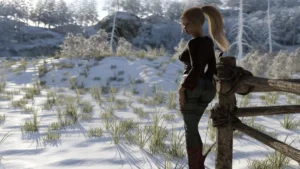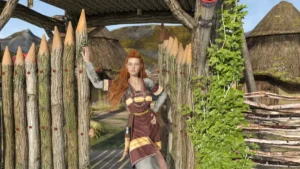
SnowStorm
Play SnowStorm
SnowStorm review
Explore Norse mysteries, master survival mechanics, and navigate complex character relationships in this epic adult adventure
SnowStorm stands as an ambitious interactive adventure that transports players to the frozen Nordic landscapes of Njardarheimr, where three Viking clans navigate coexistence and conflict. Developed by GleenX Studio, this narrative-driven experience combines strategic gameplay with meaningful player choices that shape your journey through ancient Norse mysteries. Whether you’re drawn to immersive storytelling, complex character interactions, or survival mechanics that demand careful resource management, SnowStorm delivers a multifaceted experience where every decision carries weight. This comprehensive guide explores what makes SnowStorm a standout title in interactive gaming, from its dynamic weather systems to its consequence-rich dialogue mechanics that reward exploration and strategic thinking.
Core Gameplay Mechanics and Player Interaction Systems
Let me tell you about the time I almost lost my first playthrough of SnowStorm within the first hour. 🥶 I’d just stumbled out of a shipwreck, my character Alex shivering on a frozen beach, and I spotted a cluster of berries on a nearby bush. Without a second thought, I ate them. Big mistake. An hour later, my screen was blurry, my stamina was draining rapidly, and I was desperately searching for medicinal herbs while being hunted by a pack of wolves. This wasn’t a scripted event; it was a direct result of my own careless action. This is the heart of SnowStorm gameplay mechanics—a world that feels alive, reactive, and deeply personal.
This game doesn’t hold your hand. It throws you into a breathtaking but brutal Norse landscape and says, “Survive. Thrive. Or perish.” Your success hinges on mastering three interconnected systems that form the core of the experience.
### How SnowStorm’s Three-Pillar Gameplay Foundation Works ❄️
The genius of SnowStorm isn’t in one single feature, but in how its core systems talk to each other. Think of it as a three-legged stool; if one leg is weak, the whole thing collapses. These pillars are Exploration, Survival, and Dialogue, and they are woven together by a relentless cause-and-effect engine.
Exploration is your gateway to everything. 🗺️ This isn’t about following glowing quest markers on a minimap. You’ll navigate treacherous, icy caves using a thermal scanner that highlights heat signatures, revealing hidden passages or dormant threats. The world is your puzzle, and your wits are the key. The exploration and survival mechanics are fused, meaning you’re not just sightseeing—you’re constantly scanning for resources, shelter, and danger.
Survival is your constant companion. This is where the resource management Viking game aspect truly shines. Every piece of flint, every strip of leather, and every scrap of food is a precious commodity. You’re not just managing health and hunger bars; you’re managing body temperature, fatigue, and even your mental fortitude. Forget to sleep in a safe shelter, and you’ll start seeing things in the snow. The dynamic weather system game can turn a simple trek across a glacier into a life-or-death scramble for cover, directly altering your exploration routes.
Dialogue is your most powerful, and most dangerous, tool. 🗣️ The character dialogue system in SnowStorm is anything but a simple multiple-choice quiz. Every exchange is a negotiation, a test of trust, or a manipulation. NPCs remember everything, and your tone, your past actions, and even your physical appearance (are you well-fed and armed, or starving and desperate?) influence their responses. This creates a web of consequence-rich gameplay choices that can open up entirely new story branches or slam doors shut forever.
To see how these pillars support each other, let’s look at this breakdown of key features:
| Gameplay Feature | Player Impact | Unique SnowStorm Mechanic |
|---|---|---|
| Dynamic Weather System | Forces real-time adaptation; blizzards can freeze dialogue options with NPCs, making social interaction impossible until you find shelter. | Weather isn’t just visual; it has mechanical teeth, affecting everything from traversal to social systems. |
| Morality-Driven Crafting | Your ethical alignment directly influences gameplay; peaceful tools crafted with empathy degrade slower, rewarding a diplomatic playstyle. | Crafting is a reflection of your character’s soul, not just their skill level. |
| NPC Interaction Depth | Talking to characters twice often reveals hidden motives and unlocks exclusive quest paths, fostering deeper world-building. | Encourages players to be inquisitive and patient, treating conversations as investigations. |
| Resource Scavenging | Every item has multiple potential uses, creating a complex web of strategic **consequence-rich gameplay choices** for every resource you find. | Promotes creative problem-solving over hoarding, as the “best” use of an item is often situational. |
### Resource Management and Environmental Interaction Strategies 🪓
This is where SnowStorm separates the casual visitors from the true survivors. The resource management Viking game loop is incredibly satisfying because it’s deeply intelligent. You’re not just collecting 10 bear pelts; you’re making strategic decisions about every single item in your inventory based on immediate need, long-term goals, and potential consequences.
The environmental interaction SnowStorm offers is some of the most organic I’ve ever seen. The world isn’t a static backdrop; it’s a interactive toolkit. You can:
– Melt specific patches of ice with a focused torch to create drinking water or reveal hidden compartments. 💧
– Carefully track animal prints in the snow to hunt for food, but be warned—you might be the one being hunted.
– Make the heart-wrenching decision to burn a rare, story-rich journal for a few moments of life-saving warmth.
This system forces you to prioritize survival against knowledge, a theme central to the Norse mysteries you’re unraveling.
Pro Tip: Never underestimate a “useless” item. Context is everything in SnowStorm. A rock isn’t just a rock; it’s a distraction tool, a weapon, or a weight for a trap.
Let me give you a concrete example of this interconnected thinking. Early on, I found a discarded battery in a ruined outpost. My first instinct was to hoard it. But the game’s design encourages you to think about utility. I had a choice:
- Use it to power a broken radio at a nearby cliffside, potentially calling for help and unlocking a new narrative thread. This was a long-term, hope-driven consequence-rich gameplay choice.
- Combine it with some scrap metal and wires to create a crude detonator to clear a rockslide blocking a cave rumored to contain a powerful artifact. This was a short-term, goal-oriented choice.
I chose the detonator. It worked, and I got the artifact. But two days later, I met a character who was desperately searching for functional radio parts to contact his family. My decision to use the battery had, hours earlier and miles away, closed off that entire compassionate story path. He treated me with cold indifference, and a potential ally was lost. This is the brilliance of SnowStorm’s exploration and survival mechanics—they are never just about you and the environment; they are about you and the entire living world.
### Character Development Through Organic Choice Systems 🧭
In most games, you build a character by allocating skill points into a tree. In SnowStorm, you build Alex through your actions. This is the most profound aspect of the SnowStorm gameplay mechanics. The game doesn’t have a traditional skill tree; instead, your capabilities evolve based on how you consistently behave in the world.
Your character dialogue system expertise, for instance, isn’t leveled up by points. It deepens through practice and success. If you repeatedly choose honest and empathetic dialogue options and follow through on your promises, NPCs will begin to trust you more readily. They’ll share secrets, offer better trades, and might even come to your aid in a fight. Conversely, a pattern of lies and intimidation will make you feared, which has its own short-term benefits but isolates you in the long run.
This philosophy extends to every part of your development:
– Medical Proficiency: You don’t just unlock “Better Healing.” By repeatedly successfully identifying and using herbs to cure ailments (like my berry poisoning), Alex naturally becomes more proficient, crafting more potent poultices and identifying rare plants faster. 🪴
– Combat Prowess: Choosing to engage in combat and using specific weapons makes Alex more effective with them. But choosing to sneak past enemies or use the environment to your advantage makes you stealthier and more creative in avoiding conflict altogether.
– Diplomatic Acumen: This is forged entirely through the consequence-rich gameplay choices you make in conversations. Successfully negotiating a tense standoff between two rival clans will permanently increase your reputation and open up new diplomatic pathways.
The dynamic weather system game even plays into this. I once got caught in a sudden blizzard while escorting a wounded NPC back to camp. My choice was simple: save myself by abandoning him, or risk both our lives to get him to safety. I chose the latter, and it was a brutal struggle against the wind and cold. We made it, barely. That single action, driven by the weather, did more for my reputation as a trustworthy leader than any dozen dialogue choices could have. It was an emergent, unscripted moment of character definition.
Remember my initial advice about talking to NPCs twice? 🧠 This is a cornerstone of the character dialogue system. The first conversation often gives you the surface-level quest or information. The second conversation, once you’ve built a sliver of trust or have new information from your explorations, is where the real magic happens. You uncover hidden fears, secret agendas, and alternative objectives that can completely change how you approach a situation. It teaches you to listen, not just hear.
Ultimately, mastering SnowStorm is about understanding that every action is a thread in a larger tapestry. Your resource management Viking game decisions shape your physical capabilities, your exploration and survival mechanics define your knowledge of the world, and your approach to the character dialogue system determines your place within it. It’s a challenging, deeply rewarding experience where you don’t just play a hero—you become one, through a million small, meaningful consequence-rich gameplay choices.
SnowStorm represents a sophisticated approach to interactive gaming, blending Norse mythology with meaningful player agency and complex relationship systems. The game’s three-pillar gameplay foundation—exploration, resource mastery, and consequence-rich dialogue—creates an experience where every decision carries weight and shapes your unique narrative journey. From managing scarce resources in frozen landscapes to building relationships with characters across three Viking clans, SnowStorm demands both strategic thinking and emotional investment. The technical polish, regular content updates, and multi-platform availability make it accessible to players across different systems, while the Ren’Py engine ensures smooth performance even on modest hardware. Whether you’re drawn to immersive storytelling, complex character interactions, or survival mechanics that reward careful planning, SnowStorm delivers a comprehensive adventure that respects player choice and encourages multiple playthroughs to explore different narrative paths. For those seeking a narrative-driven experience where your decisions genuinely matter, SnowStorm stands as a compelling choice in interactive entertainment.






























